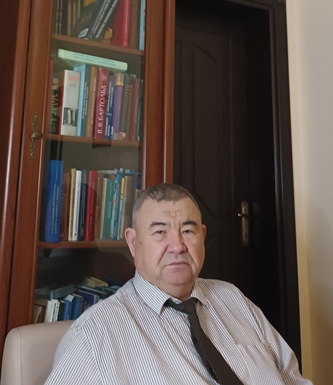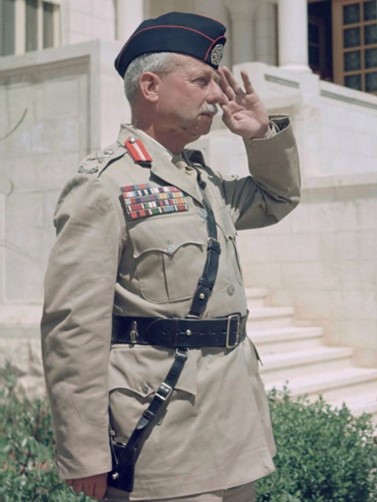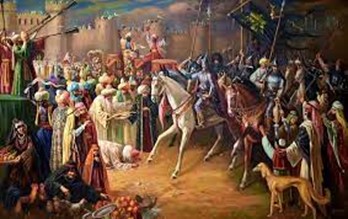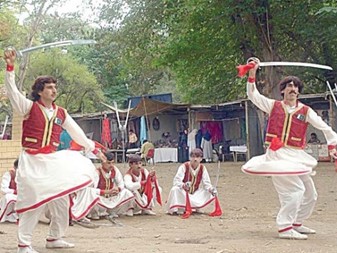Begench Karaev
In the mid-1990s, during the first years of his work in Islamabad as ambassador to Pakistan, S. Berdiniyazov continued to study possible ways and mechanisms for establishing direct ties between his host country and Turkmenistan. In this case, Sapar Komekovich often turned again to the situation in Afghanistan, because the potential routes to the north were bound to pass through this country. It is also no coincidence that in the activities of the embassy to activate diplomatic channels to promote industrial, energy and transport and communication projects in the direction of South Asia, in particular to Pakistan, the past experience in Karachi came in handy. The thing is that at the very beginning of his diplomatic career, Sapar Komekovich became a direct participant in the political and diplomatic support for the implementation of the largest project in the history of Pakistan’s industry – the creation of a metallurgical plant in Karachi (Pakistan Steel Mills). The construction of the plant, which began back in 1973, was completed in 1985, at the height of the aggravation of Pakistani-Soviet relations due to the Afghan conflict. Here we can add that the completion of the construction of this giant coincided with the beginning of the internal collapse of the builder itself – the USSR, which then stepped on the rake of “perestroika”. The steel plant was designed to produce 1.1 million tons of steel per year and had built-in capacity to double its annual production.
Interestingly, until 1979, more than three hundred Pakistani students studied at Soviet universities, specializing in engineering, medicine, economics, physics, Russian literature, law and political science. All of these students were completely exempt from annual tuition fees and also received monthly maintenance stipends. By the way, the leaders of the construction of Pakistan Steel Mills, engineer Niyaz Mohammed and materials scientist Wahab Siddiqi, once received training in the Soviet Union and then themselves trained thousands of specialists. They received the highest awards of Pakistan and the USSR. Note that in 2020, the plant employed 9,350 people. As Ambassador S. Berdyniyazov notes, in those years, Pakistan’s attitude towards the Soviet Union was “simply magnificent”, and with the start of the so-called “Afghan campaign”, former friends were transformed into sworn enemies.
There was a whole range of reasons, which were based on many circumstances due to the acute domestic political situation and complex processes related to the domestic and foreign policy of Pakistan. The initial period of S. Berdyniyazov’s work in Karachi coincided with the fact that on July 5, 1977, the country’s president, Zulfiqar Ali Bhutto, was overthrown in a military coup and executed two years later. General Zia-ul-Haq came to power, who de facto abolished the constitution and a year later, on July 5, 1978, also became the Minister of Defense and Minister of Foreign Affairs of Pakistan.
With the entry of Soviet troops into Afghanistan in late December 1979, Zia-ul-Haq allowed the US authorities to use Pakistan as a rear base for training the Mujahideen and logistical support for the Afghan resistance movement. In 1979-1989, the Afghan resistance movement received significant support and military material assistance from Western countries, while Pakistan was territorially and technically the main base of the militants.
The beginning of our hero’s diplomatic career is also significant because in January 1977, Zbigniew Brzezinski became National Security Adviser to US President Jimmy Carter. He entered the history of that period as a theorist, organizer and inspirer of the Afghan resistance to the Soviets, which was accompanied by the process of fanatical Islamization of the Mujahideen movement in Afghanistan. But Z. Brzezhinsky considered his main task to be a significant weakening of the systemic enemy – the USSR, diverting his attention from European affairs and linking gigantic resources in a qualitatively different direction – the Afghan direction. At the same time, it was also necessary to rebuild the theory of military and partisan actions, taking into account the mountain landscape and the specifics of Eastern society. There are some assumptions that Z. Brzezinski sometimes studied individual pages of John Fagot Glubb’s classic book on the military art of the Seljuks, The Course of Empire: The Arabs and Their Successors.
No less interesting is the Khattak dance – a fast dance with a saber and a scarf, which since ancient times is usually performed by representatives of the Pashtun Khattak tribe in Pakistan and some eastern regions of Afghanistan. Khattaka is the only dance that has withstood the test of time over the centuries, still remaining essentially almost in its original form.
This dance was once performed as military training by Khattak warriors and is known today as the only dance to include real swordsmanship. The fast pace with which the Khattak dance begins and ends distinguishes it from all other Pashtun folk dances, which are collectively called “atanr”. A departure from the Khattak, all other Pashtun folk dances start at a slow pace and become fast with time. In total, there are 12 steps in the Khattak dance, which require remarkable skills and preparation from the dancer. Each step should last no more than two minutes, otherwise there will simply not be enough endurance for the entire dance.
The task for Brzezinski was to “ignite the khattaks” throughout the area where the Pashtuns lived, where on the battle scenes the “mujahideen dancers” would spin in the whirlwinds of the “dance” but with “Kalash” instead of swords. Here, of course, the Muse is doomed to silence, which inspired the creator of the great “Gayane” Aram Khachaturian and the brilliant improviser on the theme of saber dance, Salvador Dali.
Before turning to the details of the biography of the largest “hawk” in modern American history, we note some strange at first glance pattern in Russian-American relations over the past almost two centuries. They alternate with cycles of hostility and the predominance of good will, as can be seen from the events that have accompanied the course of the processes of world politics.
For example, during the Crimean War of 1853-1856, the only influential power remaining friendly to Russia was the United States. American volunteers, including surgeons, helped the Russian troops. When the British and French, after the fall of Sevastopol, held a banquet in San Francisco, not one of the invited Americans came there, and the banquet hall itself was smashed by the crowd. At the same time as Russia, America felt threatened: it would be in its interests to quickly defeat Paris and London in the Crimea and complete the alliance between them.
Natives of the United States took part in the hostilities. 30 American doctors were hired by the Russian army resisting the invasion, and 15 engineers were helping to build railroad tracks to solve Russia’s biggest logistical problem in the Crimean War. Almost immediately, an international scandal erupted: contrary to the status of a neutral power, the United States, without waiting for the end of the war, supplied Russia with a steamship ordered by it in advance. And then France and Great Britain found out about equipping Russian marques at shipyards in the United States. An official protest by both powers followed, which was ignored.
The then St. Petersburg appreciated the gesture of the Americans. First, Nicholas I, and then Alexander II, who replaced him, sent letters of thanks to Washington with the wording “for words of support and encouragement and for generous help.”
During the American Civil War, which began in April 1861, Russia did not become an indifferent observer. The then foreign minister, Alexander Gorchakov, wrote to the American ambassador: “Only Russia stood by your side from the very beginning and will continue to do so. Above all, we desire the preservation of the American Union as an undivided nation. <…> Russia was made proposals to join the intervention plans. Russia will reject any proposals of this kind. You can count on us.” Before parting in the 20th century, Russia and the United States were useful to each other for a hundred years and often defended their interests together.
In the Russo-Japanese conflict of 1904-1905. US President Theodore Roosevelt acted as an intermediary in resolving the situation, agreeing on June 2, 1905 to assume the functions of an “honest broker” in future peace negotiations and offering the city of Portsmouth (New Hampshire) as the venue. On August 22, 1905, a peace conference opened there. But, at the same time, the American position on it was not impartial and disinterested. Taking, in words, “the cause of universal peace to heart,” the United States wanted to limit Russia’s influence in Asia and ahead of time agreed with Japan on the delimitation of spheres of influence. The Americans got freedom of action in the Philippines, and the Japanese in Korea.
After the October Revolution of 1917, the United States of America refused to recognize the Soviet government. The impetus to start a new political dialogue was given by trade ties established between the two countries in the late 1920s and early 1930s. The interest of US business circles in trade with the Soviet state played a significant role in the normalization of relations with the Soviet Union.
In 1923, a number of members of the US Congress visited Moscow. All their comments boiled down to the fact that the position of the Soviet government is very strong, and the USSR is “a country of the greatest opportunities and a huge market, and America must come to an agreement with the Soviet government without delay, otherwise others will enter into an agreement with it.” However, the presidential elections in 1924 and the particularly sensational “oil Panama” pushed back for a while the question of the USSR in the United States, as well as other international problems.
In the future, the change of cycles is confirmed by the alliance in the Second World War and the joint creation of the UN, then – the crisis in the first half of the 60s and detente in the mid-70s, and again the aggravation in the early 80s in connection with the Afghan events that became the quintessence of the Cold War ”, which ended with the collapse of the USSR.
Here we return to the activities of Z. Brzezinski, who became the architect of luring the Soviets into the Afghan swamp of the Cold War. How can one not recall the legendary Russian serf Ivan Susanin, who saved the young Tsar Mikhail Romanov and his mother, nun Marfa, by deceiving the pursuing Polish-Lithuanian invaders into a disastrous forest thicket. Susanin was subjected to severe torture, but did not give out the place of refuge of the newly enthroned young king and was tortured to death by the Poles and Lithuanians.
Zbigniew, being a Pole by origin, probably knew about this episode of the Russian-Polish war of the early 17th century, which happened exactly two hundred years before Napoleon’s invasion of Russia. But in this case, Napoleon himself took on the role of Susanin and ruined the glorious French army. Was Zbigniew haunted by a thirst for revenge on Russian tsars, if not commoners like Susanin, centuries later?
There are dozens of hypotheses here as to why the American elite of the late 70s went to an aggravation with the USSR after the détente that gave birth to the Helsinki Accord. After all, there are aphorisms of German Chancellor Otto von Bismarck almost a century old, squeezed out of the experience of history itself. In particular, this genius, who revived the German nation at the end of the 19th century, left the following testaments to his descendants: “I know 100 ways to lure a Russian bear out of its den, but I don’t know a single one how to drive it back. Don’t tease the Russian bear” or “Make alliances with anyone, start any kind of war, but never touch the Russians.”
The paradoxical irony of history is that these prophetic instructions were not followed and led to catastrophe a beautiful and smartest nation, and the whole world, his compatriot corporal, who declared himself the Fuhrer of the Third Rome.
But on the other hand, if you think about it, the same wills could be left to the future politicians and the military by the British, who fell victims of two wars against the Afghans during the 19th century and another at the beginning of the 20th century. As you know, the finale of the first war was the complete – in fact, to the last Englishman – the destruction of the British army. To be precise, on January 6, 1842, not far from Jalalabad, the Afghans completed the extermination of Elphinstone’s detachment. Of the 16 thousand people who retreated from Kabul, the only person survived – Dr. Bryden, who on January 14, wounded and completely exhausted by hunger, reached Jalalabad.
At the same time, the strategist Z. Brzezinski knew very well and learned the lesson of history through the assimilation of the essence of the rooted nickname of the Afghan land as a “graveyard of empires”, and therefore he intended to push Russia there. At first glance, it was not so difficult, given that at the head of the decrepit, but still quite strong Soviet empire, were the so-called “Kremlin elders” headed by “dear Leonid Ilyich”, that is, the general Secretary Brezhnev. This kind of Executive board was unique – consisting of only secretaries, headed by the general secretary. It means that Comrade Stalin, the creator of the Soviet power hierarchy under the throne of the General Secretary, looked very far. After all, he began his revolutionary position with the duties of a drafter of protocols, that is, secretary of the meetings of the Bolsheviks, where at the top of his stroke the chairman of the meeting, the future leader of the proletariat, Vladimir Lenin put his signature. Did the genius Lenin then know that he would soon be surpassed by his own henchman, perhaps the symbolic Salieri who killed Mozart – secretary Joseph Stalin?
Unfortunately, by the end of the Soviet Union, this position of supreme power was devalued and ridiculed by the great Soviet people themselves, who then hurried in droves and without looking back to the attraction of “Gorbachev’s perestroika and acceleration” and the “glasnost” show.

About the author: Begench Saparovich Karaev, defended his doctorate in philosophy in April 1996 in Moscow, published several monographs and dozens of articles on the theory and methodology of political analysis, including in relation to the conditions of the traditional Central Asian society. Starting from 1997, over the next almost a decade and a half, he headed the information and analytical structure of the Foreign Ministry of Turkmenistan. From April 2004 to February 2005, he conducted research and lectures at Indiana University Bloomington (Indiana University Bloomington) as part of the targeted program Fulbright for Visiting Scholars (USA). Currently, he is a senior lecturer at the IIR of the Ministry of Foreign Affairs of Turkmenistan.
To be continued…
///nCa, 26 December 2022


